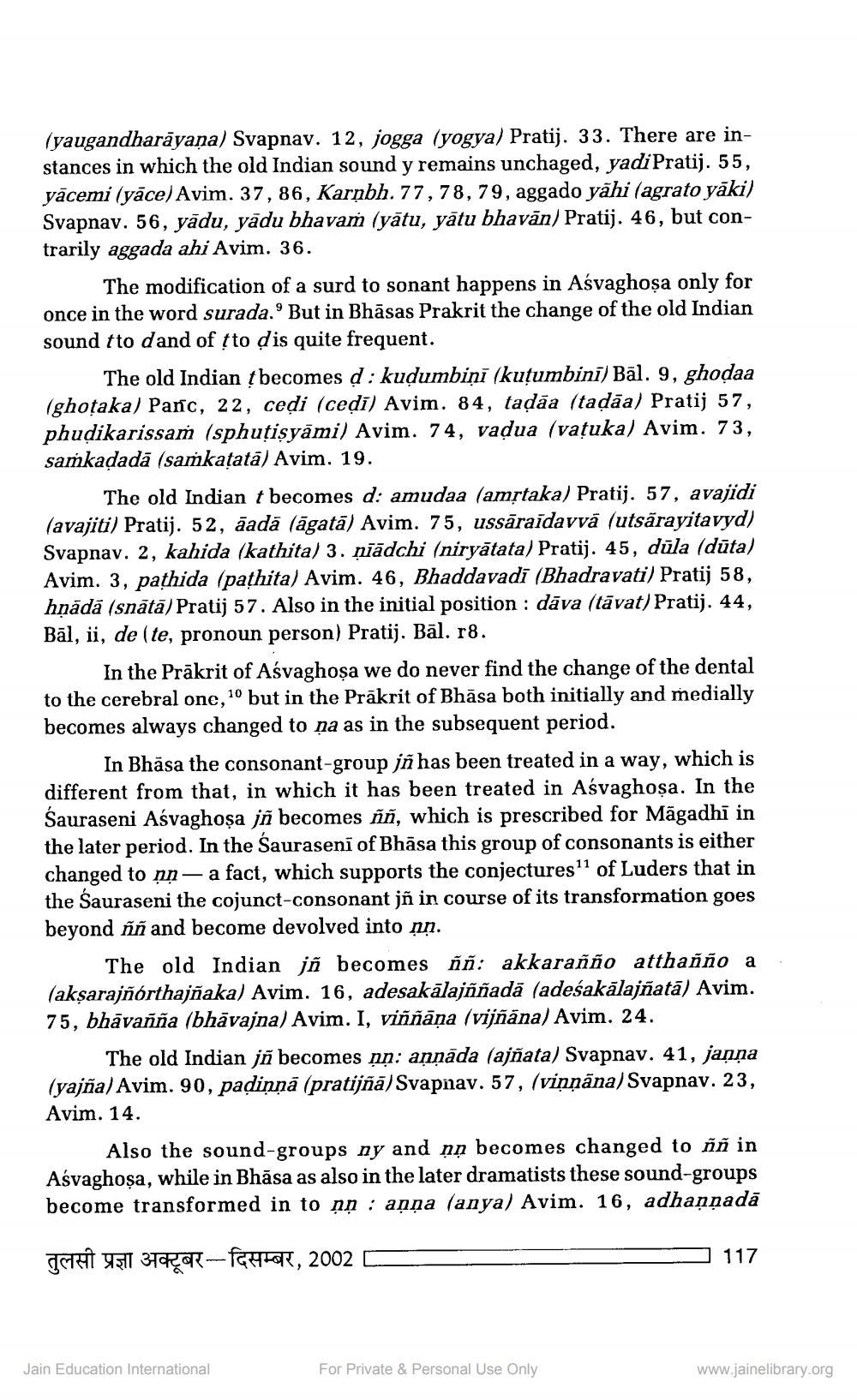________________
(yaugandharāyana) Svapnay. 12, jogga (yogya) Pratij. 33. There are instances in which the old Indian sound y remains unchaged, yadi Pratij. 55, yācemi (yāce) Avim. 37, 86, Karņbh. 77, 78, 79, aggado yahi (agrato yāki) Svapnav. 56, yādu, yādu bhavaṁ (yātu, yātu bhavān) Pratij. 46, but contrarily aggada ahi Avim. 36.
The modification of a surd to sonant happens in Asvaghosa only for once in the word surada. But in Bhāsas Prakrit the change of the old Indian sound tto dand of tto dis quite frequent.
The old Indian t becomes d : kudumbiņi (kuțumbini) Bāl. 9, ghodaa (ghotaka) Parc, 22, cedi (cedi) Avim. 84, tadãa (taļāa) Pratij 57, phudikarissaṁ (sphutisyāmi) Avim. 74, vadua (vatuka) Avim. 73, saṁkadadā (saskatatā) Avim. 19.
The old Indian t becomes d: amudaa (amstaka) Pratij. 57, avajidi (avajiti) Pratij. 52, dadā (āgatā) Avim. 75, ussāraidavvă (utsărayitavyd) Svapnav. 2, kahida (kathita) 3. niādchi (niryātata) Pratij. 45, dūla (dūta) Avim. 3, pathida (pathita) Avim. 46, Bhaddavadi (Bhadravati) Pratij 58, hņādā (snātā) Pratij 57. Also in the initial position : dāva (tāvat) Pratij. 44, Bāl, ii, de (te, pronoun person) Pratij. Bāl. r8.
In the Prākrit of Asvaghoṣa we do never find the change of the dental to the cerebral one, 1° but in the Prākrit of Bhāsa both initially and medially becomes always changed to na as in the subsequent period.
In Bhāsa the consonant-group jñ has been treated in a way, which is different from that, in which it has been treated in Asvaghosa. In the Śauraseni Aśvaghoșa jñ becomes ññ, which is prescribed for Māgadhī in the later period. In the Sauraseni of Bhāsa this group of consonants is either changed to nn- a fact, which supports the conjectures'l of Luders that in the Sauraseni the cojunct-consonant jñ in course of its transformation goes beyond ññand become devolved into nn.
The old Indian jñ becomes ññ: akkarañño atthañño a (aksarajñórthajñaka) Avim. 16, adesakālajññadā (adeśakālajñata) Avim. 75, bhāvañña (bhāvajna) Avim. I, viññāņa (vijñāna) Avim. 24.
The old Indian jñ becomes nn: aņņāda (ajñata) Svapnav. 41, janna (yajña) Avim. 90, padiņņā (pratijñā)Svapnav. 57, (viņņāna) Svapnav. 23, Avim. 14.
Also the sound-groups ny and ạn becomes changed to ññ in Asvaghosa, while in Bhāsa as also in the later dramatists these sound-groups become transformed in to ņņ : aņņa (anya) Avim. 16, adhaņņadā
getest 4311 3Torce-f4401, 2002 C
117
Jain Education International
For Private & Personal Use Only
www.jainelibrary.org




